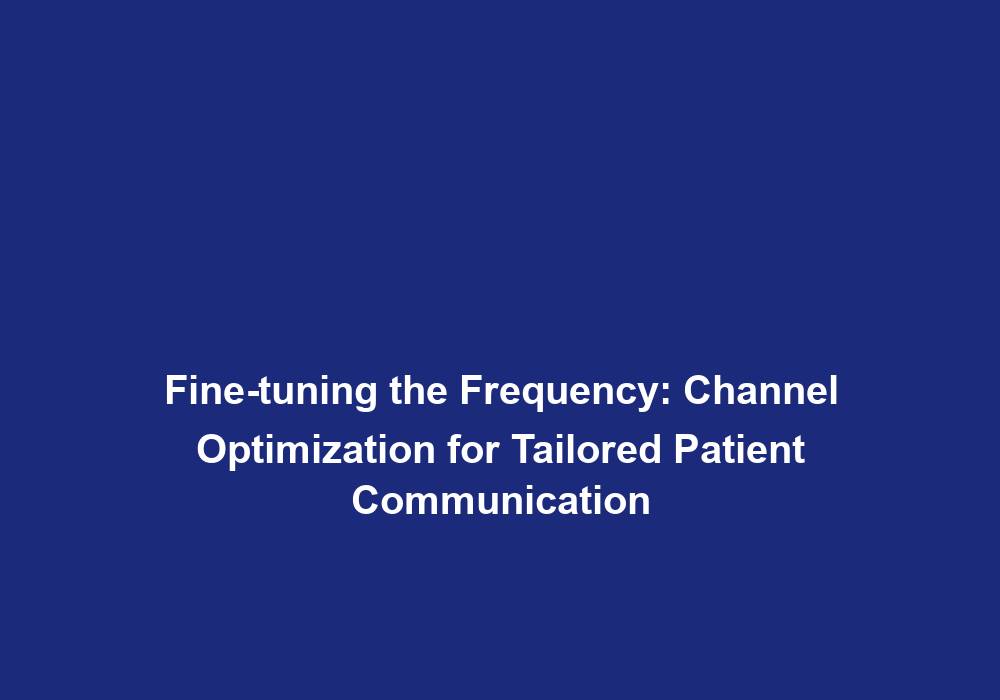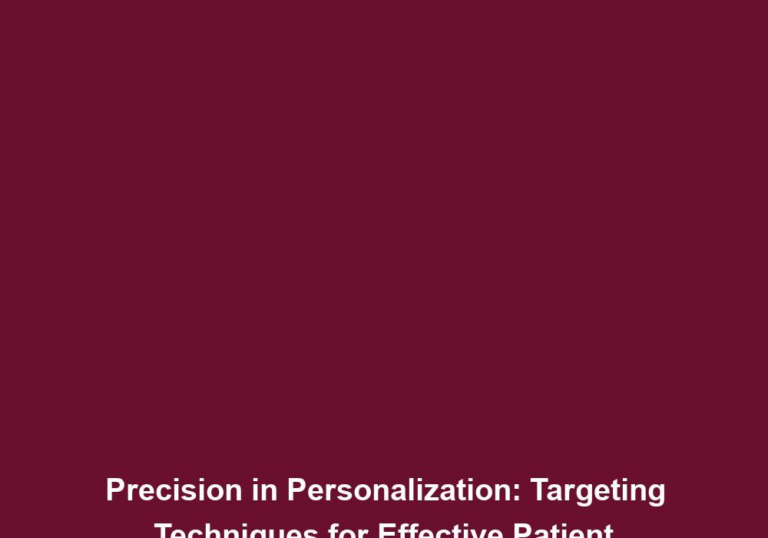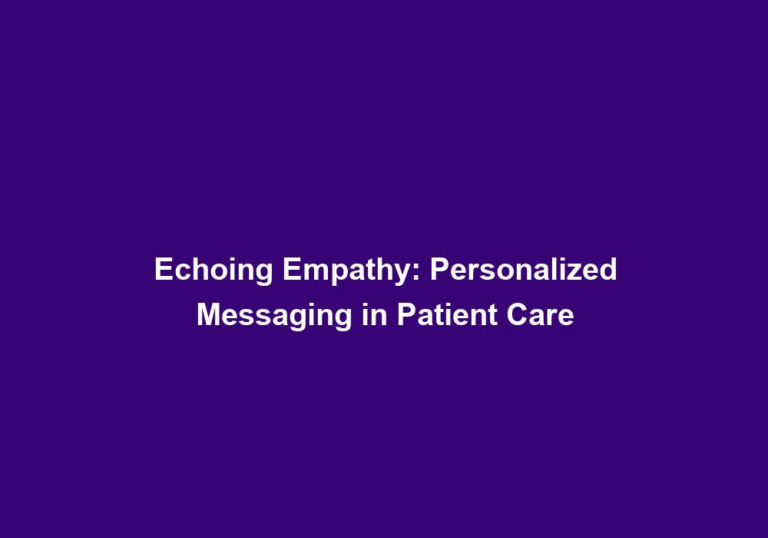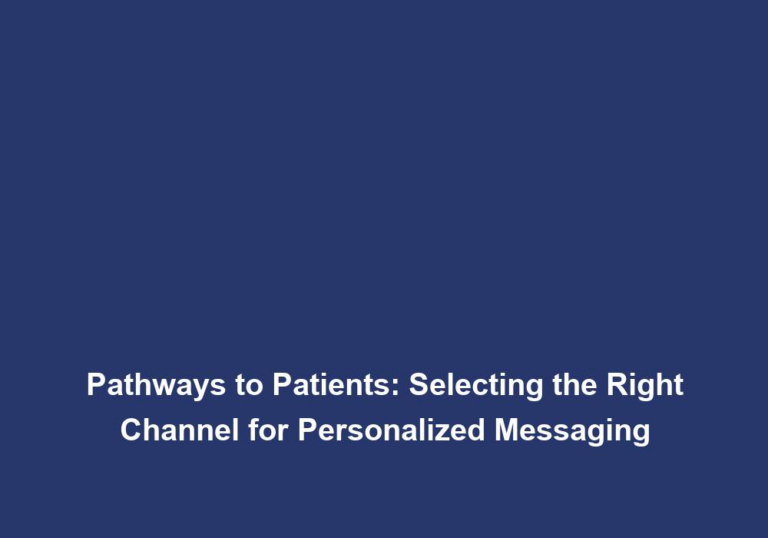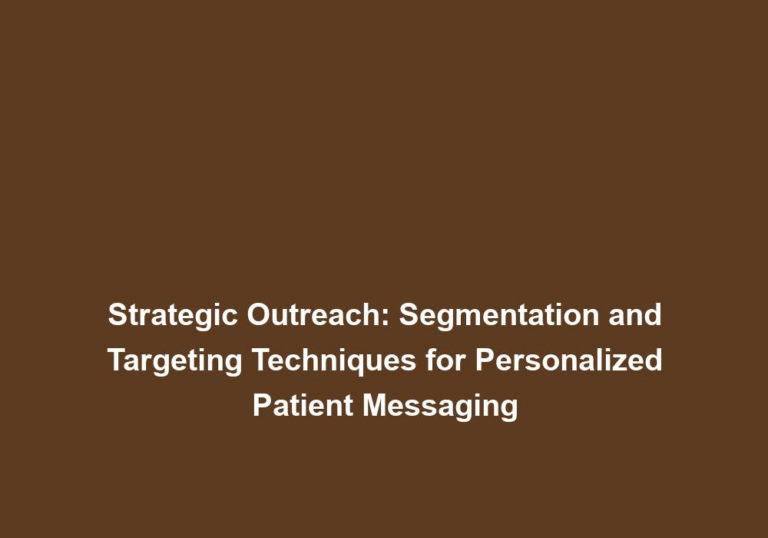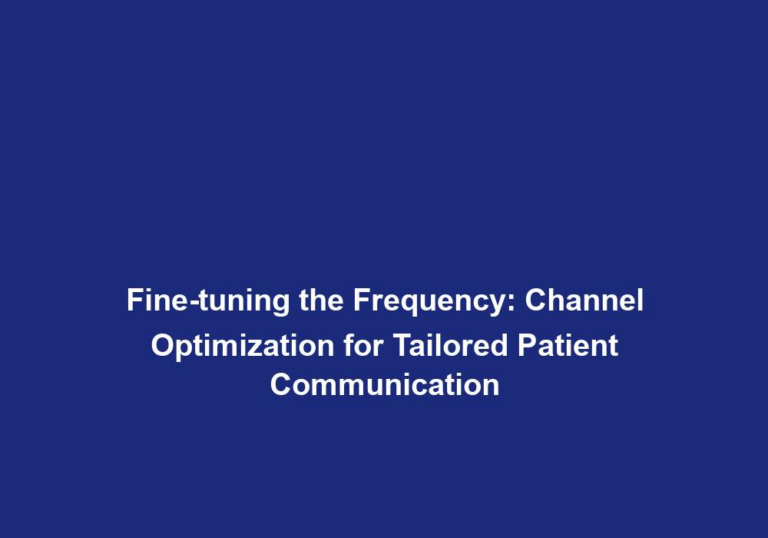Dialing into Dynamics: Optimizing Channels for Personalized Patient Messaging
In the ever-evolving healthcare landscape, personalized patient messaging has become crucial for effective communication and improved patient outcomes. With the advancements in technology and the rise of digital channels, healthcare organizations need to optimize their channels to ensure personalized messaging reaches the right patients at the right time. This article explores the dynamics of optimizing channels for personalized patient messaging, providing valuable insights for healthcare providers and marketers.
Understanding the Importance of Personalized Patient Messaging
- Enhanced Patient Engagement:
-
Personalized messaging establishes a deeper connection with patients, leading to increased engagement and satisfaction. When patients receive messages that are tailored to their specific needs and preferences, they feel valued and more likely to actively participate in their healthcare journey. By addressing patients by name and acknowledging their individual concerns, healthcare providers can foster trust and build stronger relationships.
-
It allows healthcare providers to address specific patient needs, concerns, and preferences effectively. By segmenting patients based on demographics, health conditions, or preferences, healthcare organizations can tailor messages accordingly. For example, patients with chronic conditions may require different types of messaging compared to those seeking preventive care. By understanding individual patient needs, healthcare providers can deliver information that is relevant and personalized, leading to better patient satisfaction and outcomes.
-
Personalized messaging also plays a crucial role in patient education. By delivering educational content that is specific to a patient’s condition or treatment plan, healthcare providers can enhance the learning experience. For example, patients with diabetes may receive messages about managing blood sugar levels, while those with hypertension may receive information about lifestyle modifications to lower blood pressure. By providing patients with targeted educational resources, healthcare organizations can empower them to make informed decisions and take an active role in their own health.
- Improved Adherence to Treatment Plans:
-
Customized messages focusing on treatment reminders, medication instructions, and lifestyle modifications significantly improve patient adherence. By sending automated reminders via SMS or email, healthcare providers can ensure that patients take their medications as prescribed and follow recommended treatment plans. This not only helps patients stay on track with their healthcare regimens but also reduces the risk of complications or worsening of their conditions. Personalized messaging can also include information about potential side effects or precautions, helping patients make informed decisions regarding their medications.
-
By tailoring messages to individual patient needs, healthcare providers can positively impact treatment outcomes. For example, patients who receive personalized messages about the importance of medication adherence and lifestyle modifications are more likely to follow their treatment plans consistently. Moreover, by monitoring patient engagement patterns and preferences, healthcare organizations can identify the most effective channels and message types for each patient. This allows for continuous optimization of messaging strategies to maximize patient adherence and improve overall health outcomes.
- Effective Health Education:
-
Personalized messaging caters to patient-specific educational content, creating a more engaging and impactful learning experience. When patients receive information that is directly relevant to their health conditions or concerns, they are more likely to pay attention and absorb the knowledge effectively. By delivering educational content through various channels such as email, patient portals, or social media, healthcare organizations can reach patients in ways that suit their preferences and ensure they receive the information they need to manage their health effectively.
-
By delivering relevant information, patients can better understand their health conditions and make informed decisions. Personalized messaging allows healthcare providers to provide patients with tailored information about their specific conditions, treatment options, and available resources. For instance, patients diagnosed with a chronic disease may receive messages about self-management techniques, support groups, or additional educational materials. By empowering patients with knowledge, healthcare organizations can help them become active participants in their own care, leading to improved health outcomes and a higher quality of life.
Optimizing Channels for Personalized Patient Messaging
To successfully optimize channels for personalized patient messaging, healthcare organizations need to consider the following strategies:
1. Embrace Multi-Channel Approach
By leveraging multiple channels, healthcare providers can reach patients through their preferred communication methods. Key channels to consider include:
-
SMS/Text Messaging: Quick and direct communication for appointment reminders, test results, or medication alerts. This channel is particularly effective for time-sensitive information or urgent communication.
-
Email: Allows for more detailed messaging, including educational resources and personalized treatment plans. Email is suitable for delivering comprehensive information that patients can access at their convenience.
-
Patient Portals: Secure platforms that enable patients to access personalized messages, medical records, and interact with healthcare providers. Patient portals offer a centralized hub for communication and can be accessed by patients at any time, facilitating ongoing engagement and information sharing.
-
Social Media: Engage patients with informative and educational content, community support, and direct messaging for personalized queries. Social media platforms provide an opportunity to connect with patients in a more informal and interactive manner, fostering engagement and building a sense of community.
By utilizing a multi-channel approach, healthcare organizations can ensure that personalized messaging reaches patients through their preferred channels, increasing the likelihood of message reception and engagement.
2. Leverage Data and Analytics
Utilizing patient data and analytics is essential for optimizing channels and delivering personalized messaging effectively. Key considerations include:
-
Segmentation: Categorize patients based on demographics, health conditions, or preferences to tailor messages accordingly. By understanding the characteristics and needs of different patient groups, healthcare providers can deliver messages that resonate with each individual, increasing the chances of message effectiveness and engagement.
-
Behavioral Tracking: Monitor patient engagement patterns to identify preferred channels and message types. By analyzing patient interactions with different channels and messages, healthcare organizations can gain insights into patient preferences and adapt their messaging strategies accordingly. For example, if a patient consistently engages with SMS reminders but rarely opens emails, it may be more effective to prioritize SMS for that particular patient.
-
A/B Testing: Experiment with different messaging approaches to determine the most impactful content and delivery methods. By conducting A/B tests, healthcare organizations can compare the effectiveness of different messages, formats, or channels. This iterative process allows for continuous improvement and optimization of messaging strategies, ensuring that personalized messages are delivered in the most impactful way possible.
3. Ensure Message Consistency and Coherence
Consistency and coherence across channels are vital to maintain a unified patient experience. Consider the following:
-
Branding: Ensure that messaging aligns with the organization’s brand and voice, reflecting a cohesive image. Consistent branding across channels helps patients recognize and trust the messages they receive, enhancing the overall impact and effectiveness of personalized patient messaging.
-
Message Personalization: Tailor messages to address patients by name and include relevant details specific to their health journey. Personalization goes beyond simply inserting the patient’s name into a message. It involves considering the patient’s unique circumstances, treatment plans, and preferences to create messages that resonate and provide value. By showing patients that their individual needs are acknowledged and addressed, healthcare organizations can foster stronger patient-provider relationships and improve patient engagement.
-
Content Adaptation: Adapt messaging to suit the characteristics and limitations of each channel while maintaining consistency in core messaging. Different channels have different capabilities and limitations. For example, SMS messages have character limitations, while email allows for more extensive content. Healthcare organizations should ensure that the core message remains consistent across channels while adapting the format and delivery to suit each channel’s requirements. This ensures that the overall messaging strategy is cohesive and delivers a unified patient experience.
4. Implement Automation and AI
Automation and AI technologies can streamline personalized patient messaging processes, saving time and effort. Consider the following automation strategies:
-
Appointment Reminders: Automate reminders via SMS or email, reducing no-show rates and optimizing scheduling processes. By automating appointment reminders, healthcare providers can ensure that patients receive timely notifications and are more likely to attend their appointments. This not only improves patient engagement but also optimizes resource allocation within healthcare organizations.
-
Medication Adherence: Utilize automated messages to remind patients to take their medications at prescribed times. By implementing automated medication reminders, healthcare providers can improve patient adherence and reduce the risk of medication-related complications. Automated reminders can be personalized to consider individual medication schedules and preferences, ensuring that patients receive the right messages at the right time to support their treatment plans.
-
Health Education: Implement AI-driven chatbots to provide instant responses to patient queries and offer personalized educational content. AI-driven chatbots can simulate human-like conversations and provide patients with accurate and relevant information in real-time. By leveraging AI technology, healthcare organizations can scale their patient education efforts, providing personalized support and guidance to a larger number of patients efficiently.
By implementing automation and AI technologies, healthcare organizations can optimize the delivery of personalized patient messaging, enhance operational efficiency, and improve patient outcomes.
5. Prioritize Patient Privacy and Security
Maintaining patient privacy and data security is crucial in optimizing channels for personalized patient messaging. Follow these best practices:
-
HIPAA Compliance: Ensure compliance with the Health Insurance Portability and Accountability Act (HIPAA) regulations for secure messaging. Healthcare organizations must protect patient health information and ensure that messaging platforms and processes meet the required privacy standards.
-
Encryption and Authentication: Implement robust security measures to protect patient data during transmission and storage. Encryption and authentication protocols should be in place to safeguard patient information and prevent unauthorized access.
-
Consent Management: Obtain patient consent for messaging and clearly outline the purpose, scope, and frequency of communication. Patients should have control over the type and frequency of messages they receive, and healthcare organizations must respect their preferences and privacy.
By prioritizing patient privacy and security, healthcare organizations can build trust with patients and ensure that personalized messaging is delivered in a safe and responsible manner.
Conclusion
Optimizing channels for personalized patient messaging is paramount to drive patient engagement, improve treatment adherence, and enhance health outcomes. By embracing a multi-channel approach, leveraging data and analytics, ensuring message consistency, implementing automation and AI, and prioritizing patient privacy and security, healthcare organizations can unlock the full potential of personalized patient messaging in today’s digital era. Remember, success lies in delivering the right message to the right patient through the right channel at the right time.

